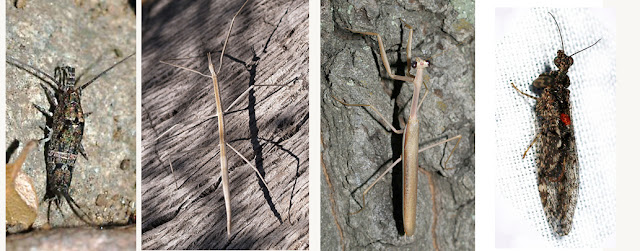Black lights, of course, draw the good fliers first. That evening, we were immediately inundated by hundreds of Phyllophaga vetula, a chunky, hairy June beetle. Scores of Anomala delicata followed soon after.
Soon a bristletail and a stick insect walked up, and a slim beige Mantis with surprisingly dark eyes, and a mantispid came to prey on 'our' bugs.
The most common Cerambycid was Methia mormona (top, middle), but we were also visited by a huge Prionus heroicus (left), several delicately spotted Orwellion gibbulum arizonense (right) and a tiny Sternidus decorus mMiddle, bottom). A number of Bycids in the the genera Aneflus and Oeme are still unidentified.
Weevils were represented by two Curculio spp (left). and the broadnose weevil Pandeleteius buchanani.
Surprisingly several Sunburst Beetles Thermonectus marmoratus (right) and two Whirligig Beetles Dineutus sublineatus (left), all living in shallow ponds, showed up. We couldn't find any water close by, but the beetles are good fliers who often approach shiny surfaces like car roofs and lights.
The only carabids appearing in numbers looked like Selenophorus which we ignored because they are impossible to id. We also got several specimens of a tiny Bombadier Beetle that hopefully will be a new species for me. Jeff collected Lebia mimics of the Bombadier Beetles even though they do fly - he needs some control groups for his flightless stuff.
Walking along the trail with flash lights, we found two larger cerambycids, Enefalodes hispinicornis and a Prionid. Both are good fliers, so I got them for my photo collection.
Jeff was happy with his collection of large flightless Darkling Beetles like Eleodes subnitens and longicollis on the trail, and Strongylium atrum (above) on tree trunks.
We also found several very attractively shaped Embaphion sp. I hope to keep one of them alive and happy for the U of A Beetle festival on the 27th of September (Tucsonans, mark your calendars!).
Windscorpions (Solifugiae) were racing about at top speed, with Jeff in hot pursuit.
Under a rocky overhang an impressive Cat-faced Orbweaver, Araneus illaudatus, was hanging out in her over 20 in wide net.
Meanwhile at the black light, interesting moths had arrived: Clock-wise: Manduca rustica, Gerrodes minatea, Euclidia diagonalis, Syssphinx hubbardi, Datana sp.
While we were observing arthropods, fellow vertebrates were spying on us: A Woodhouse's Toad, two Gray Foxes and a gang of Havelinas took their turns.
Maybe we were set up right in the path of their evening rounds.

















Wow! You guys got a lot of cool insects. Mantid flies are awesome, but I've only ever seen one in my life. I'm thinking one of these evenings I may try setting up a white sheet and a light in our backyard and see what comes flying over.
ReplyDeleteThis was wonderful!! I too am thinking about doing a sheet and light project :))) Thanks so much for such a cool post!!
ReplyDeleteAlthough I'm not a 'bug' lover (some of them are creepy!) I do enjoy your blog posts. The variety of life here is amazing, so thank you for your great pictures and descriptions.
ReplyDeleteP.S. I drove the road you mention on the back side of the mountain; in a small car; when I first moved here and didn't know any better!!
ReplyDeleteAll your work is extraordinary, congratulations! We enjoy your blog a lot and my sons and me make a good use of it. Thanks a lot to share it out!
ReplyDeleteWonderful pictures. And what a wealth of creatures. The title had me a little worried though. I was afraid it was a recipe.
ReplyDeleteWowee, lotsa cool stuff! What fun :D
ReplyDeleteNice that you saw the Thermonectus, along with all the rest!
ReplyDeleteLooking forward to starting our Arizona adventure in about a week.
thanks this is good blog.
ReplyDeletePendant Lights